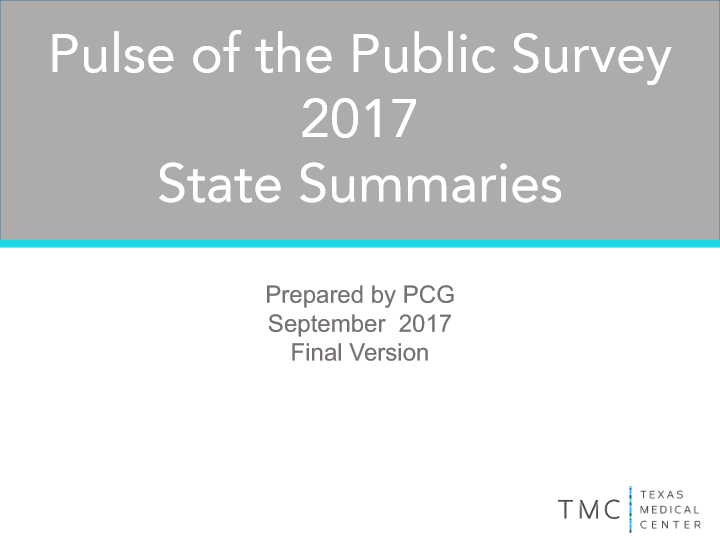The Nation’s Pulse: The Texas Medical Center's Consumer Survey
The annual survey provides insight into the public’s attitudes about hot-button health policy issues.
This is an archived page highlighting results of the 2017 survey. The 2018 survey results are available here.
2017 Results
2017 Highlights
About the 2017 Survey
The 2017 web-based survey polls more than 9,000 residents across 15 states: Arizona, California, Florida, Georgia, Illinois, Indiana, Michigan, New Jersey, New York, North Carolina, Ohio, Pennsylvania, Tennessee, Texas and Washington. The states were selected based on their political breadth in order to ensure they give the Health Policy Institute insights into the views of a broad cross section of Americans. Additionally, for the first time, this year we fielded a separate survey of physicians that asks them about their views of the health care system.
Since its launch in 2015, the TMC Consumer Health Report has yielded surprising results that highlight changing perspectives on some of the most pressing health issues affecting the American public. Through this annual survey, the TMC Health Policy Institute aims to continue shedding light on how the views of everyday citizens could shape health policy decisions of the future.
Key Findings
- Americans are virtually unanimous: they value health insurance
- At a time when federal lawmakers are debating the future of health care, the survey found that 98 percent of consumers surveyed consider health insurance important to them and their families. That figure was virtually unchanged across red, blue and swing states. The findings suggest Americans are more united on the issue than federal policymakers might realize.
- Half the country makes sacrifices to pay for health care
- The survey examines the question of affordability in several ways, but one figure stands out in particular: 49 percent of consumers surveyed must cut other expenses to pay for health care. Consumers said they cut back on savings, as well as spending on food and clothes, to pay for their health expenses. Health care isn’t just a health issue; it’s an economic issue.
- Consumers and lawmakers don’t see eye to eye on “affordability”
- Most uninsured respondents say they can only afford spending 2 percent of their income on health care. Why is this figure significant? The Affordable Care Act’s individual mandate requires people to obtain health insurance or pay a penalty. Those who lack access to “affordable” coverage are exempt from that penalty. But under ACA, coverage is considered “affordable” if it doesn’t exceed 8.2 percent of income. This suggests the public’s view of what’s affordable is vastly different from lawmakers’ view of affordability.
- Physicians and consumers are united in identifying causes of – and solutions to – rising health care costs
- Forty-seven percent of physicians surveyed blamed insurance companies for rising health care costs, compared to 28 percent of consumers. Meanwhile, 19 percent of physicians and 30 percent of consumers blamed drug and device manufactures for rising costs. However, relatively few respondents from both categories blamed hospitals or physicians.
- Both groups agreed that the most effective ways to reduce health care costs are to increases costs for those with unhealthy habits – such as people who smoke or are obese – and to make affordable, catastrophic health care plans available to consumers.
- Paying doctors salaries, instead of fee-for-service, could reduce health care costs
- It is estimated that nearly $200 billion per year is spent on overtreatment, or care that can’t possibly help patients. If more doctors were paid with salaries, instead of paid based on the volume of care they provide, research suggests they’d order fewer tests and procedures, reducing costs.
- The survey indicates doctors would actually support this solution, with 69 percent of physicians preferring to be compensated via a straight salary, or a salary with relatively small incentives.


















